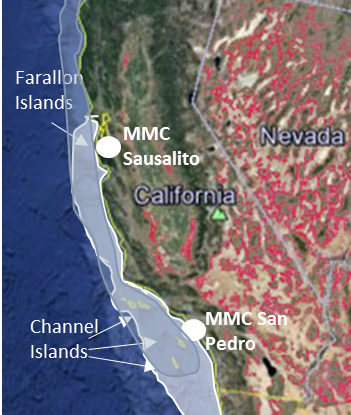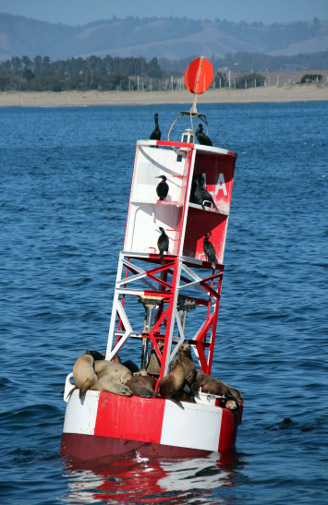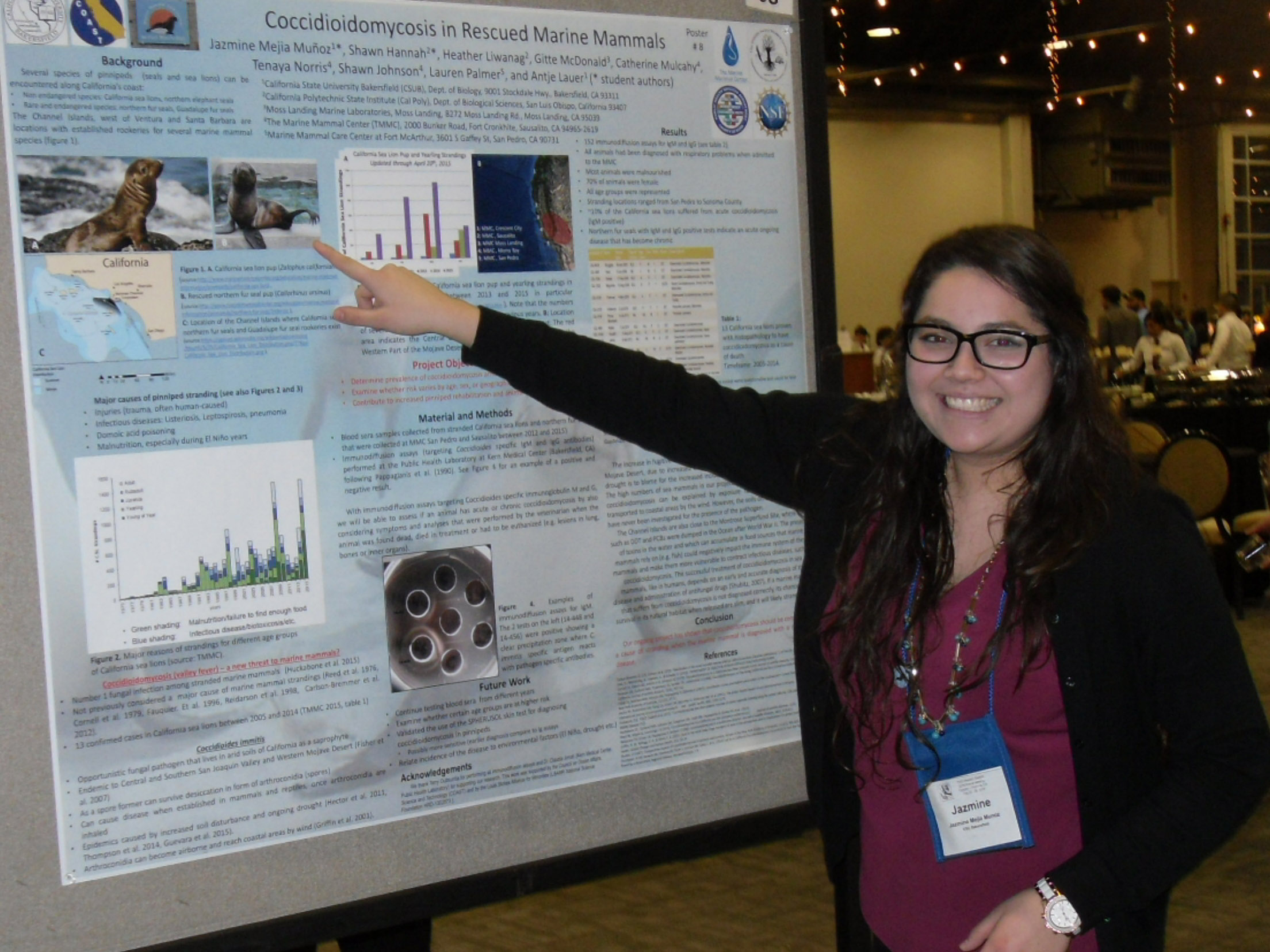Dr. Antje Lauer and Jazmine Mejia Muñoz, CSU Bakersfield
Dr. Heather Liwanag and Shawn Hannah, Cal Poly San Luis Obispo
Dr. Gitte McDonald, Moss Landing Marine Labs
October 12, 2016

Map of the southwestern U.S. showing the range of Coccidioides spp. based on soil parameters suitable for sustaining the growth of the pathogen (red). California sea lions generally roam in the area off the coast shaded in white. California sea lions and Northern fur seals breed on the Channel Islands and Farallon Islands.
Coccidioidomycosis, also known as “valley fever” is a fungal disease caused by the soil-borne pathogens Coccidioides immitis and Coccidioides posadasii, which are endemic to California’s Central Valley, the Antelope Valley (Northern Los Angeles County) and the Los Angeles Basin. The disease generally starts with a lung infection but can spread to other parts of the body when not recognized early. Historically, coccidioidomycosis has not been considered a major cause of pinniped strandings because it is not endemic to the areas of California where pinniped rookeries are found, primarily the coast and the Channel Islands. However, fungal spores can become airborne when soil is disturbed and transported by the wind to non-endemic areas. Over the last decade fugitive dust emissions have increased due to the ongoing drought and increased soil disturbance in the Antelope Valley and the Los Angeles Basin, especially during strong Santa Ana winds. Therefore, pinnipeds and other marine mammals, as well as humans, are at risk of contracting coccidioidomycosis in non-endemic areas of the pathogen. Between 2005 and 2014, thirteen confirmed cases of coccidioidomycosis were detected in California sea lions (Zalophus californianus).
A record stranding of California sea lions and other marine mammals was observed in the spring of 2015 along California’s coast. From January-April 2015, California sea lion strandings were over 17 times the average stranding level for the same period during 2004-2012. Previous surveys of stranded pinnipeds between 1975 and 2000 identified malnutrition, renal disease and pneumonia as major causes of stranding. However, since coccidioidomycosis was previously shown to be the most prevalent mycosis among marine mammals stranded along California’s coast, the 2015 mass stranding event provided us with the opportunity to investigate the frequency of exposure to Coccidioides spp. among marine mammals and their susceptibility to this fungal pathogen. We also aimed to determine whether coccidioidomycosis should be considered as a new underlying cause of pinniped strandings in California between 2013 and 2015.A record stranding of California sea lions and other marine mammals was observed in the spring of 2015 along California’s coast. From January-April 2015, California sea lion strandings were over 17 times the average stranding level for the same period during 2004-2012. Previous surveys of stranded pinnipeds between 1975 and 2000 identified malnutrition, renal disease and pneumonia as major causes of stranding. However, since coccidioidomycosis was previously shown to be the most prevalent mycosis among marine mammals stranded along California’s coast, the 2015 mass stranding event provided us with the opportunity to investigate the frequency of exposure to Coccidioides spp. among marine mammals and their susceptibility to this fungal pathogen. We also aimed to determine whether coccidioidomycosis should be considered as a new underlying cause of pinniped strandings in California between 2013 and 2015.

California sea lions (Zalophus californianus) resting on a buoy close to
the coast (photo credit: Gitte McDonald).
Blood and stool samples are collected from stranded marine mammals when they are admitted to Marine Mammal Centers in order to diagnose any infection. Portions of the samples are frozen and thus represent a historical resource that can be useful later on in investigating the prevalence of certain diseases in the stranded and rescued populations over time. The record number of stranding of California sea lions and other rarer pinnipeds, such as northern fur seal pups (Callorhinus ursinus), in 2015 provided us with an abundance of blood serum samples from that particular year, and we were able to obtain previously collected blood serum samples from animals that stranded in 2013 and 2014.Blood and stool samples are collected from stranded marine mammals when they are admitted to Marine Mammal Centers in order to diagnose any infection. Portions of the samples are frozen and thus represent a historical resource that can be useful later on in investigating the prevalence of certain diseases in the stranded and rescued populations over time. The record number of stranding of California sea lions and other rarer pinnipeds, such as northern fur seal pups (Callorhinus ursinus), in 2015 provided us with an abundance of blood serum samples from that particular year, and we were able to obtain previously collected blood serum samples from animals that stranded in 2013 and 2014.
We sent samples to the Public Health Laboratory in Kern County, which specializes in Coccidioides antibody detection in humans, to test for the presence of two different Coccidioides specific antibodies, immunoglobulin M (IgM) and immunoglobulin G (IgG), using immunodiffusion assays. The presence of Coccidioides-specific IgM, which is formed early during the disease process, can indicate an acute infection. Detection of high quantities of Coccidioides-specific IgG can indicate a chronic infection especially when symptoms typical for coccidioidomycosis are observed such as pneumonia, persistent skin lesions and/or unsuccessful treatment with antibiotics. Lower quantities of Coccidioides-specific IgG in an asymptomatic animal may indicate that it was exposed to Coccidioides in the past but successfully battled the disease and is now immune to the pathogen.We sent samples to the Public Health Laboratory in Kern County, which specializes in Coccidioides antibody detection in humans, to test for the presence of two different Coccidioides specific antibodies, immunoglobulin M (IgM) and immunoglobulin G (IgG), using immunodiffusion assays. The presence of Coccidioides-specific IgM, which is formed early during the disease process, can indicate an acute infection. Detection of high quantities of Coccidioides-specific IgG can indicate a chronic infection especially when symptoms typical for coccidioidomycosis are observed such as pneumonia, persistent skin lesions and/or unsuccessful treatment with antibiotics. Lower quantities of Coccidioides-specific IgG in an asymptomatic animal may indicate that it was exposed to Coccidioides in the past but successfully battled the disease and is now immune to the pathogen.
Overall, we performed 150 immunodiffusion assays to detect IgM and IgG in blood serum samples from 134 California sea lions (all age groups) and 16 northern fur seals (only pups) that stranded between 2013 and 2015. California sea lion immunodiffusion assays were positive for IgM in 14% of the samples in 2013, 10% of the samples in 2014 and 6.5% in 2015. IgG however was detected in only about 2% of the samples each year. Among the Northern fur seal pups included in this study, we also found two individuals that were IgM positive and two more that were IgM and IgG positive. It should be considered however that some immunoglobulins, including IgG and IgM, can cross the placenta and/or be transferred to a pup through the mother’s milk. The presence of IgM or IgG in a pup may indicate that the mother was exposed to the pathogen rather than the pup itself. Therefore a positive immunodiffusion assay in a pup has to be evaluated carefully and a diagnosis made in conjunction with other observations.

CSU Bakersfield Undergraduate student Jazmine Mejia-Munoz presenting a poster at the Meeting of the Western Section of the Wildlife Society in Pomona in February 2016.
We are planning to perform additional immunodiffusion assays on California sea lion blood samples from 2013-2016, and we have obtained a permit from NOAA Fisheries that allows us to continue this project until 2021. We will add
SPHERUSOL skin testing as an additional means of detecting antibodies against Coccidioides spp. We have determined that the skin test can be safely performed on California sea lions and we will compare the sensitivity of this skin test to immunodiffusion assay results in the coming months. Students involved in this project have presented the findings of this study at several meetings. We are currently seeking additional funding to continue this project, which was initiated with COAST support, and will soon submit our first collaborative manuscript for publication.
Dr. Antje Lauer is an Associate Professor in the Department of Biology at CSU Bakersfield. Jazmine Mejia Muñoz is an undergraduate working with Dr. Lauer at CSU Bakersfield.
Dr. Heather Liwanag is an Assistant Professor in the Biological Sciences Department at Cal Poly San Luis Obispo. Shawn Hannah was an undergraduate student working with Dr. Liwanag who graduated in 2016.
Dr. Gitte McDonald is an Assistant Professor at Moss Landing Marine Labs. COAST provided funding for this project:
Rapid Response Funding Program Award# COAST-RR-2015-003, July 2015.